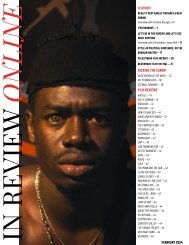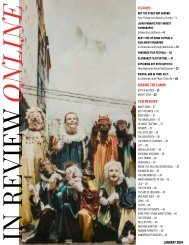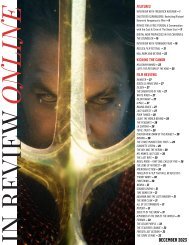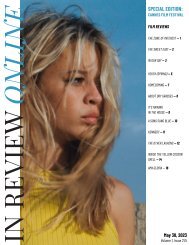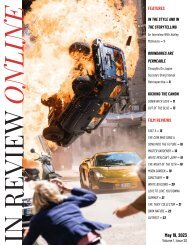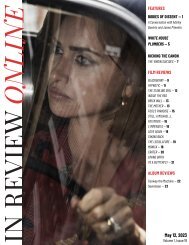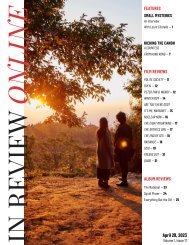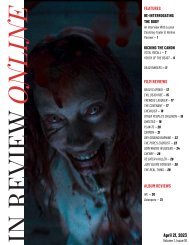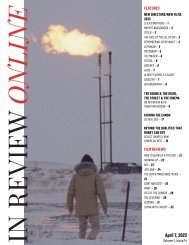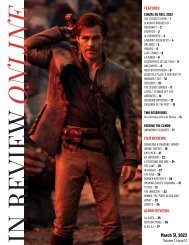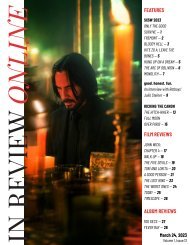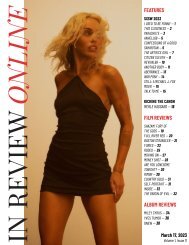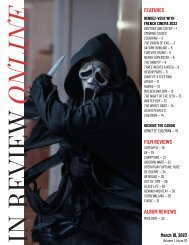You also want an ePaper? Increase the reach of your titles
YUMPU automatically turns print PDFs into web optimized ePapers that Google loves.
FILM REVIEWS<br />
JACKALS & FIREFLIES<br />
Charlie Kaufman<br />
Depending on your disposition, New York City’s claustrophobic<br />
crush of humanity is either unsettling or liberating, if not both<br />
simultaneously <strong>—</strong> it’s not easy to find your foothold in a place<br />
where crying in public is both a rite of passage and a punchline.<br />
There are many, many love letters to New York City out there, but<br />
Charlie Kafuman’s Jackals & Fireflies is less a declaration of<br />
devotion than a wistful, extended Missed Connection. An<br />
unnamed narrator, played with gentle gravitas by the poet Eva<br />
H.D., crisscrosses the city in an unspecified time frame, noting or<br />
forging fragments of connection amidst the buffeting streams of<br />
urban ambiance. In keeping with Kaufman’s surrealist<br />
sensibilities, Jackals & Fireflies is a meandering tone poem<br />
whose only other major character is the city itself.<br />
H.D., who wrote the 20-minute film’s script, most recently<br />
collaborated with Kaufman by penning the poem “bonedog” for<br />
I’m Thinking of Ending Things. Like fellow flaneur Leopold Bloom,<br />
who wanders through Dublin in equally mesmerizing fashion,<br />
H.D.’s narration is a loose amalgamation of stream of<br />
consciousness and internal monologue, peppered with wry<br />
observation and personal reflection. Cinematographer Chayse<br />
Irvin (Blonde and BlacKkKlansman) shot the film with a Samsung<br />
Galaxy S22 Ultra as part of a new campaign, but unlike<br />
high-budget shot-on-iPhone features, Jackals & Fireflies retains<br />
a down-to-earth moodiness that befits its pensive subject. Even<br />
in the face of solitude, there’s more than a little serendipity; it’s<br />
their fleeting coexistence that Kaufman, in his own understated<br />
way, chooses to celebrate. <strong>—</strong> SELINA LEE<br />
DIRECTOR: Charlie Kaufman; CAST: Eva H.D.; DISTRIBUTOR: <strong>—</strong>;<br />
STREAMING: February 12; RUNTIME: 20 min.<br />
GODS OF MEXICO<br />
Helmut Dosantos<br />
Helmut Dosantos’ feature debut, Gods of Mexico, is an ethereal<br />
work of observation, informing tonality through compositional<br />
rigor, the beauty on display siphoned into a controlled stasis. In<br />
opposition to historical narratives of modernization and the<br />
industrial imperialism that ravages the landscapes of indigenous<br />
communities, Dosantos seeks an immobility that dignifies itself<br />
through the act of statis-as-resistance. He frames a collection of<br />
indigenous peoples in a plethora of tableaux so that, when<br />
brought together, they might construct a new perception and<br />
narrative of resilience. But this well-meaning survey of beauty<br />
and might quickly collapses into the ornamental.<br />
At a point, the film’s stillness and observation becomes rote, its<br />
capacity to evoke its ideas and aestheticized vision begins to<br />
stifle, and the whole thing pretty openly flails toward<br />
ethnographic gaze. One might be able to extrapolate intention in<br />
invoking beauty as a faculty of the very representation it<br />
expresses, but there isn’t enough of a sense of subjectivity as the<br />
camera’s inherent estrangement seriously affects our perception.<br />
These people become objects of a leering gaze, one that flirts in<br />
spectacle and only affirms that the indigenous subjects are<br />
being made fetish. A black-and-white portraiture motif adopted<br />
during the film’s mid-section reads as grotesquely projected<br />
nostalgia, seeking to render those images of history as specters<br />
within a reimagining of this process, wherein their ghosts are<br />
caught in that quest for an image. These forms, if<br />
reappropriated, offer little new but a pointed reflexivity. In the<br />
portraits, we see figures ripped from their storied landscapes<br />
and placed on display.<br />
The intent is clear enough: of seeking reclamation of these<br />
historied images through a context of labor and inserting <strong>—</strong> and<br />
12



